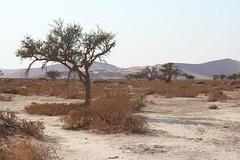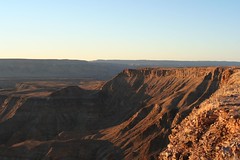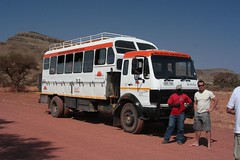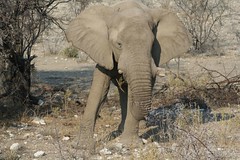
Click on pic to see slideshow
or here to access the set
What could have prompted a nation usually characterized by thoughtfulness and calculated intelligence, to throw itself into a futile colonial adventure in the least hospitable patch of African desert? Once you have seen Namibia, you can’t help asking yourself this question. This barren stretch of land on the southwestern coast of the continent, home to some of the most ruthless temperature extremes, doesn’t look like a rewarding prize, no matter how starved for land or glory the few Germans that started this insane adventure may have been, a hundred years ago. Whether they really wanted colonies or they just wanted to annoy the British, their pathetic choice of location must have made them the laughingstock of jokes at the Whitehall for a while. The dream only lasted for thirty-five years (until the British got annoyed indeed), but it left a legacy that is still visible today: commercial signs and billboards along the road are often in German and the centers of the old colonial outposts of Lüderitz and Swakopmund look like miniature German towns, with gabled houses, protestant churches, Schweinebraten, Erdinger Weissbier and Bavarian Gemütlichkeit...
The first days of our trip we rolled along the coast to the Orange river, which marks the border between South Africa and Namibia, and then inched our way north on the highways that have become unpaved as soon as we crossed the border. This part of Namibia is the land of wire fences, of which there are miles and miles as long as your eyes can see, along the road and across the land. Those wires may be there to isolate wildlife from cattle ranches (of which I haven’t seen any) or maybe they protect the environment from the devastating hordes of tourists; either way I can’t help noticing the irony of partitioning and fencing out patches of this arid land sprinkled with little boulders which look like salt and pepper fallen from the sky … is every Namibian entitled to its own desert lot?
For hours each day we roll through the desert in our sturdy Mercedes truck specially retrofitted for the purpose of transporting tourists on safaris. It has an elevated passenger cabin and plenty of storage space underneath, for luggage, tents, mattresses, folding chairs, food and cooking utensils. Each day, our guides, Ian and Thembe and the driver, all three from Zimbabwe, prepare breakfast and lunch for us by the side of the truck, and most days they also cook dinner. Occasionally, we have to buy our own dinner meal, when we stay overnight in a town, or in certain campsites. After the horror of camping on the Inca trail, I was reluctant to sleep in a tent for so many nights (the trip takes 40 days), but it hasn’t been too bad so far, because the tent mattresses are thick (not the kind you can roll and attach to your backpack) and your hipbone and shoulders don’t hurt in the morning. The voyage is not entirely without pain though – sitting in a vehicle for hours in a row has always given me backaches, and I’m not the only one to feel happy when we take a break from driving and we can stretch our legs walking around. The distances between the tourist spots are immense, so we do spend quite a lot of hours driving, but there’s something good in this as well: we have been reading book after book in the past days.
It wasn’t until we got to Namibia – when we reached Sossusvlei, the country’s number one attraction – that we understood what desert heat really was. There was no more pleasant breeze; there were no more clouds and no trees. The air lay on the land like a blanket of hot coals. For us, every moment spent out of shade was just another moment spent looking for shade. However I still found this dry heat more bearable than the sweltering, humid Yucatan hothouse. If the wind would pick up while we were camping, we had to wait for it to stop and then clean the inside of the tents and everything that was in them, waging a bitter losing battle against the fine, permeating, ubiquitous African dust. If you travel in Africa there is no choice but to get used to the dust, which has become a permanent companion since we left the lush lands of the Cape. In camp sites, at lunch stops along the road, on the majestic dunes of the Sossusvlei Sea of sand, in the Etosha National Park, in our truck – which rides with open windows most of the time – everywhere we go, dust is king. After a day in the open my hair feels so thick with all the dirt in it that I almost forget I don’t have much of it left. Fortunately there are showers and hot water at every camp site.

Click on pic to see slideshow
or here to access the set
The group isn’t very interesting or particularly cohesive, which is a convoluted way of saying that I didn’t have much fun getting to know the other people we shared the truck with. But it isn’t bad either. The guides have lots of stories about Africa; they tell funny anecdotes about past safaris they have lead, they talk about African traditions, but mostly, they like to talk about Zimbabwe, their homeland. The troubles of their land preoccupy them like a sore spot; heartfelt and with bitter irony, they talk about the ruin that has befallen their beloved country, about “Uncle Bob” – Robert Mugabe, their eternal president who holds onto power like a fish on a hook, and about his irrational politics that seem to be cut out of equal parts of tragedy and comedy.
Namibia is mostly desert, but one teeming with wildlife, and there’s no place like the Etosha National Park to convince you of this. Zebras, giraffes, wildebeest, kudus, oryxes, springboks, elephants, rhinos, lions and tigers roam free through the thorny bushes, looking for food, water or shadow, all but ignoring the curious rolling metal beasts that roar and puff passing by, with their load of strange little two-legged creatures armed with their inoffensive one-eyed weapons… Did I mention tigers? Of course, there are no tigers in Africa, but how can I not put lions and tigers together after years of having this song on my mind: http://www.weebls-stuff.com/toons/kenya? It just won't go away...
Posted from Livingstone, Zambia, two countries later...







1 comment:
Your photos make me envious :)
Post a Comment